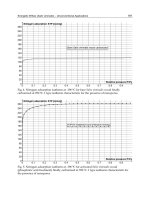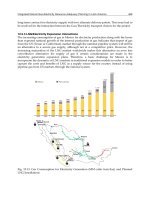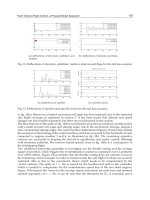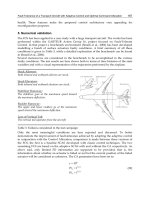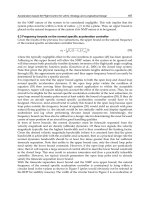Advances in Vehicular Networking Technologies Part 11 docx
Bạn đang xem bản rút gọn của tài liệu. Xem và tải ngay bản đầy đủ của tài liệu tại đây (2.5 MB, 30 trang )
Advances in Vehicular Networking Technologies
292
navigational aids, vibrotactile stimulation systems that use several vibrators in the shape of
a cap (Cassinelli et al. 2006), rings (Amemiya et al. 2004), a vest (Erp et al. 2005), belt (Tan et
al. 2003; Heuten et al. 2008), and glove (Zelek et al. 2003) have been proposed.
Unfortunately, these tactile approaches require that users learn how to convert stimuli to
information. This is not intuitive and requires training since the tactile stimuli employed are
basically non-directional.
8. Acknowledgements
We thank Dr. Ichiro Kawabuchi for his technical assistance. We also thank Hisashi
Sugiyama, the staff of Kyoto City Fire Department, and the staff of the Kyoto Prefectural
School for the Visually Impaired for their kind cooperation. This study was supported by
Nippon Telegraph and Telephone Corporation and was also partially supported by the
sponsorship of the Fire Defence Agency, Japan.
9. References
Amemiya, T.; Ando, H. & T. Maeda T. (2005). Virtual force display: Direction guidance
using asymmetric acceleration via periodic translational motion, Proceedings of
World Haptics Conference, IEEE Computer Society, pp. 619-622.
Amemiya, T.; Ando, H. & T. Maeda T. (2008). Lead-Me interface for pulling sensation in
hand-held devices, ACM Transactions on Applied Perception, Vol. 5, No. 3, pp. 1-17.
Amemiya, T. & Maeda, T. (2008). Asymmetric oscillation distorts the perceived heaviness of
handheld objects, IEEE Transactions on Haptics, Vol. 1, No. 1, pp. 9-18.
Amemiya, T. & Maeda, T. (2009). Directional force sensation by asymmetric oscillation from
a double-layer slider-crank mechanism, Journal Computing Information Science in
Engineering, Vol. 9, No. 1, 011001.
Amemiya, T.; Maeda, T. & Ando, H. (2009). Location-free Haptic Interaction for Large-Area
Social Applications, Personal and Ubiquitous Computing, Vol. 13, No. 5, pp. 379-386,
Springer.
Amemiya, T. & Sugiyama, H. (2009). Haptic Handheld Wayfinder with Pseudo-Attraction
Force for Pedestrians with Visual Impairments, Proceedings of 11th ACM Conference
on Computers and Accessibility (ASSETS 2009), Pittsburgh, PA, pp. 107-114.
Amemiya, T. & Sugiyama, H. (2010). Orienting Kinesthetically: A Haptic Handheld
Wayfinder for People with Visual Impairments, ACM Transactions on Accessible
Computing, Vol. 3, No. 2, pp. 1-23.
Amemiya, T.; Yamashita, J.; Hirota, K. & Hirose, M. (2004). Virtual Leading Blocks for the
Deaf-Blind: A Real-Time Way-Finder by Verbal-Nonverbal Hybrid Interface and
High-Density RFID Tag Space, In Proc. of IEEE Virtual Reality Conference 2004 (VR
2004), pp. 165-172.
Bradley, A. & Dunlop, D. (2005). An experimental investigation into wayfinding directions
for visually impaired people, Personal Ubiquitous Computing, Vol. 9, No. 6, pp. 395-
403.
Cassinelli, A.; Reynolds, C. & Ishikawa, M. (2006). Augmenting spatial awareness with
haptic radar. In Proc. International Conference on Wearable Computing. IEEE Computer
Society, pp. 61-64.
Kinesthetic Cues that Lead the Way
293
Coren, S.; Ward, L. M. & Enns, J. T. (2003). Sensation and Perception. John Wiley and Sons,
Inc.
Crandall, W.; Brabyn, J.; Bentzen, B. & Myers, L. (1999). Remote infrared signage evaluation
for transit stations and intersections. Journal of Rehabilitation Research and
Development Vol. 36, pp. 341-355.
Enriquez, M. & MacLean, K. (2008). The role of choice in longitudinal recall of meaningful
tactile signals. In Proc. of 16th IEEE Symposium on Haptic interfaces for virtual
environment and teleoperator systems. pp. 49-56.
Erp, J. B. F. V.; Veen, H. A. H. C. V.; Jansen, C. & Dobbins, T. (2005). Waypoint navigation
with a vibrotactile waist belt. ACM Transactions on Applied Perception, Vol. 2, No. 2,
pp. 106-117.
Foulke, E. (1996). The roles of perception and cognition in controlling the mobility task.
International Symposium on Orientation and Mobility.
Golledge, R. G. (1992). Place recognition and wayfinding: making sense of space. Geoforum
Vol. 23, No. 2, pp. 199-214.
Gurocak, H.; Jayaram, S.; Parrish, B. & Jayaram U. (2003). Weight sensation in virtual
environments using a haptic device with air jets, Journal of Computing and
Information Science in Engineering, Vol. 3, No. 2. ASME, pp. 130-135.
Hayward, V. (2008). A Brief Taxonomy of Tactile Illusions and Demonstrations That Can Be
Done In a Hardware Store, Brain Research Bulletin, Vol. 75, pp. 742-752.
Heuten, W.; Henze, N.; Boll, S. & Pielot, M. (2008). Tactile wayfinder: a non-visual support
system for wayfinding. In NordiCHI. ACM International Conference Proceeding Series,
Vol. 358. ACM Press, pp. 172-181.
Hirose, M.; Hirota, K.; Ogi, T.; Yano, H.; Kakehi, N.; Saito, M. & Nakashige, M. (2001).
HapticGEAR: The Development of a Wearable Force Display System for Immersive
Projection Displays, Proceedings of Virtual Reality 2001 Conference, pp. 123–130.
Hoshi ,T.; Takahashi, M.; Iwamoto, T. & Shinoda, H. (2010). Noncontact Tactile Display
Based on Radiation Pressure of Airborne Ultrasound, IEEE Transactions on Haptics,
Vol. 3, No .3, pp. 155-165.
Loomis, J.; Marston, J.; Golledge, R. & Klatzky, R. (2005). Personal guidance system for
people with visual impairment: A comparison of spatial displays for route
guidance. Journal of Visual Impairment and Blindness Vol. 8, No. 5, pp. 61-64.
Massie, T. & Salisbury, J. K. (1994). The phantom haptic interface: A device for probing
virtual objects, Proceedings of the ASME Winter Annual Meeting, Symposium on Haptic
Interfaces for Virtual Environment and Teleoperator Systems, Vol. 55-1, pp. 295-300.
Nakamura, N. & Fukui, Y. (2007). Development of Fingertip Type Non-grounding Force
Feedback Display, Proceedings of World Haptics Conference 2007, pp. 582-583.
Pielot, M., Henze, N., Heuten, W., & Boll, S. (2008). Evaluation of continuous direction
encoding with tactile belts. In Proc. the 3rd international workshop on Haptic and Audio
Interaction Design, Springer, LNCS, pp. 1-10.
Richard, C. & Cutkosky, M. (1997). Contact Force Perception with an Ungrounded Haptic
Interface, Proceedings of the ASME Dynamic Systems and Control Division, pp. 181–
187.
Ross, D. & Blasch, B. (2000). Wearable interfaces for orientation and wayfinding. In Proc.
ACM Conference on Assistive Technologies. ACM Press, pp. 193-200.
Advances in Vehicular Networking Technologies
294
Suzuki, Y.; Kobayashi, M. & Ishibashi, S. (2002). Design of force feedback utilizing air
pressure toward untethered human interface, Proceedings of CHI ’02 Extended
Abstracts on Human Factors in Computing Systems. ACM Press, 2002, pp. 808-809.
Swindells, C.; Unden, A. & Sang, T. (2003). TorqueBAR: an ngrounded haptic feedback
device. Proceedings of the 5th international conference on multimodal interfaces. ACM
Press, pp. 52-59.
Tan, H. Z.; Gray, R., Young, J. J. & Traylor, R. (2003). A haptic back display for attentional
and directional cueing. Haptics-e: The Electronic Journal of Haptics Research Vol. 3,
No. 1.
Tanaka, Y.; Masataka, S.; Yuka, K.; Fukui, Y.; Yamashita, J. & Nakamura, N. (2001). Mobile
torque display and haptic characteristics of human palm. Proceedings of 11th
international conference on augmented tele-existence, pp. 115-120.
Wilson, J.; Walker, B.; Lindsay, J.; Cambias, C. & Dellaert, F. (2007). Swan: System for
wearable audio navigation. In Proc. International Conference on Wearable Computing.
IEEE Computer Society, pp. 91-98.
Yano, H.; Yoshie, M. & Iwata, H. (2003). Development of a nongrounded haptic interface
using the gyro effect, Proceedings of 11th international symposium on Haptic Interfaces
for Virtual Environment and Teleoperator Systems. IEEE Computer Society, pp. 32-39.
Zelek, J. S.; Bromley, S.; Asmar, D. & Thompson, D. (2003). A haptic glove as a tactile-vision
sensory substitution for wayfinding. Journal of Visual Impairment and Blindness Vol.
97, No. 10, pp. 621-632.
Part 2
Transmission Technologies and Propagation
16
Technological Trends of Antennas in Cars
John R. Ojha, René Marklein and Ian Widjaja
Germany
1. Introduction
Antennas have become a commonplace in automotive applications. These are broadly
classified as wire and patch antennas which are used in cars for inter-vehicle
communication. Besides its use in the automotive sector, these antennas are also used as
arrays in the aviation sector e.g. fuselage integrated microstrip phased antenna arrays. These
wire and patch antennas can either be modeled analytically e.g. using the Green’s function,
derived from Eigen functions or numerically using various approaches e.g. MoM, FDTD,
FEM etc. Besides the common usage of wire and patch antennas of various shapes,
integrated antennas are also widely used. Antennas starting from the traditional monopole
antenna followed by patch antennas on car roof tops and mesh antennas on car windscreens
will be discussed in this chapter.
2. Figures of merit
This section lists and explains some salient figures of merit of antennas. The input
impedance and the radiated fields (near and far) are termed as the primary figures of merit
since they form the basis on which other secondary figures of merit such as VSWR,
bandwidth, and directivity etc. are determined. Section 2.1 elaborates on the primary figures
of merit viz. input impedance. Section 2.2 explains some secondary figures of merit which
are obtained from the input impedance. The theory of how the effective radiating power is
calculated from the far-field gain patterns is explained in section 2.3.
2.1 Input impedance
The input impedance Z
in
is defined as the impedance presented by an antenna at its input
terminals a – b, as shown in Fig. 1. In other words, the input impedance of an antenna is the
ratio of the voltage to the current or the ratio of the electric to the magnetic field measured at
the input terminals (feeding point). The input impedance of an antenna is expressed in
terms of its real and imaginary parts as
in in in
ZRjX,=+ (1)
where Z
in
is the antenna impedance at the input terminals a – b,
R
in
is the antenna resistance at the input terminals a – b,
and X
in
is the antenna reactance at the input terminals a – b.
Advances in Vehicular Networking Technologies
298
Fig. 1. Block diagram of a transmitting antenna
The imaginary part X
in
of the input impedance represents the power stored in the near field
region of the antenna. The resistive part R
in
of the input impedance consists of two
components, the radiation resistance R
r
and the loss resistance R
l
. The power associated with
the radiation resistance R
r
is the power actually radiated by the antenna and the loss
resistance R
l
represents the dielectric or conducting losses resulting in power dissipation.
The input impedance is of great importance in wire and patch antennas and is therefore
discussed here. The input impedance is used as a foreboding of unwanted radiation for
EMC related aspects especially in the automotive sector. However, in the case of antennas,
the input impedance with the source impedance is used as an intermediate parameter for
determining the S11 parameter, return loss, Voltage Standing Wave Ratio (VSWR), and
bandwidth. This is explained in more detail in section 2.2, where the matching
characteristics of a patch antenna and its bandwidth are explained.
2.2 Reflection coefficient / S11 / VSWR / return loss
Antennas are commonly used in various type of smart antenna systems. In order for any
given antenna to operate efficiently, the maximum transfer of power must take place
between the feeding system and the antenna. Maximum power transfer can take place only
when the input impedance of the antenna (Z
in
) is matched to that of the feeding source
impedance (Z
S
). According to the maximum power transfer theorem, maximum power can
be transferred only if the impedance of the source is a complex conjugate of the impedance
of the antenna under consideration and vice-versa. If this condition for matching is not
satisfied, then some of the power may be reflected back. This is expressed as
1||
,
1||
VSWR
+
Γ
=
−
Γ
(2)
with
,
rinS
iinS
VZZ
VZZ
−
Γ= =
+
(3)
Technological Trends of Antennas in Cars
299
where Γ is called the reflection coefficient, V
r
is the amplitude of the reflected wave, and V
i
is the amplitude of the incident wave. The VSWR is basically a measure of the impedance
mismatch between the feeding system and the antenna. The higher the VSWR, the greater is
the mismatch. The minimum possible value of VSWR is unity and this corresponds to a
perfect match. The return losses (RL), obtained from equations (2) and (3), indicate the
amount of power that is transferred to the load or the amount of power reflected back. In the
case of a microstrip-line-fed antenna, where the source and the transmission line
characteristic impedance or the transmission line and the antenna edge impedance do not
match, waves are reflected. The superposition of the incident and reflected waves leads to
the formation of standing waves. Hence the RL is a parameter similar to the VSWR to
indicate how well the matching is between the feeding system, the transmission lines, and
the antenna. The RL is
20lo
g
||RL
=
−Γ (dB). (4)
To obtain perfect matching between the feeding system and the antenna, Γ = 0 is required
and therefore, from equation (4), RL = infinity. In such a case no power is reflected back.
Similarly at Γ = 1, RL = 0 dB, implies that all incident power is reflected. For practical
applications, a VSWR of 2 is acceptable and this corresponds to a return loss of 9.54 dB.
Usually return losses ranging from 10 dB to 12 dB are acceptable.
The bandwidth could be defined in terms of its Voltage Standing Wave Ratio (VSWR) or
input impedance variation with frequency. The VSWR or impedance bandwidth of an
antenna is defined as the frequency range over which it is matched with that of the feed line
within specified limits. The BW of an antenna is inversely proportional to its quality factor Q
and is expressed as
1VSWR
BW
QVSWR
−
= . (5)
The bandwidth is usually specified as the frequency range over which the VSWR is less than
2 (which corresponds to a return loss of 9.5 dB or 11 % reflected power). Sometimes for
stringent applications, the VSWR requirement is specified to be less than 1.5 (which
corresponds to a return loss of 14 dB or 4 % reflected power). In the case of a patch antenna,
the input impedance with the source impedance is used as an intermediate parameter for
determining the S11 parameter (a measure of the reflection coefficient Γ), return loss,
Voltage Standing Wave Ratio (VSWR), and bandwidth. The return loss is expressed in dB in
terms of S11 as the negation of the return loss. The bandwidth can also be defined in terms
of the antenna’s radiation parameters such as gain, half power beam width, and side-lobe
levels within specified limits.
2.3 Effective radiating power
For every other antenna, the directivity is defined as the ratio of the radiation intensity in a
given direction from the antenna to the radiation intensity U
0
averaged over all directions. If
the direction is not specified, the direction of maximum radiation intensity is implied.
Hence mathematically the directivity is
max max
0
4
orad
UU
D
UP
π
== , (6)
Advances in Vehicular Networking Technologies
300
where
max
,
rad
UP are the maximum radiation intensity and total radiated power, expressed
in Watts / solid angle and Watts respectively.
The antenna gain is directly associated with the directivity of an antenna and is therefore
associated with only the main lobe. The term K is the radiation efficiency expressed in terms
of the conduction efficiency K
c
and dielectric efficiency K
d
as
cd
KKK=
, (7)
Gain and directivity extraction are based on the source power. Let us assume that P
t
is the
source power and P
v
are some losses in the structure (e.g. dielectric losses), then a power P
t
P
r
=P
t
- P
v
will be radiated. The directivity (as compared to an isotropic point source) is then
defined as
D = 4πR2 * (S
s
/P
r
), (8)
where S
s
= (1 /2)
F0
(|E 2 E |2 / Z )+
ϑφ
Z
F0
denotes the wave impedance of the surrounding medium.
From the equation the gain is extracted from the directivity as
GKD
=
⋅ , (9)
where
G is the gain and D is the directivity. (For an antenna with 100% efficiency, K = 1.)
The far field gain is determined from the electric far-field components
E
θ
and E
φ
and the
source power. The electric field components
E
θ
and E
φ
are calculated from the surface
electric current densities. The effective radiating power is extracted from the gain by
removing the effect of the losses in the form of metallic or /and dielectric losses.
Effective Radiating Power Gain Power loss=− (10)
3. Numerical approaches for determining figures of merit
The numerical analysis e.g. MoM can be carried out either in the spectral or in the time
domain. A patch antenna comprising metallic and dielectric parts with a feeding pin or
microstrip line is solved using the traditional MoM by decomposing the antenna as
• discretized surface parts
• wire parts
• attachment node of the wire to the surface element.
Metallic surfaces contain different basis functions as shown in Fig. 2. The MoM uses surface
currents to model a patch antenna. In the case of ideal conductors, the boundary condition
of E
tan
= 0 is applied.
The most commonly used basis functions for line currents through wires are stair case
functions, triangular basis functions, or sine functions. The MoM code uses triangular basis
functions. In contrast to wires, two-dimensional basis functions are employed for surfaces.
The current density vectors have two-directional components along the surface. Figure 2
shows the overlapping of so-called hat functions on triangular patches. An integral equation
is formulated for the unknown currents on the microstrip patches, the feeding wire /
feeding transmission line, and their images with respect to the ground plane. The integral
equations are transformed into algebraic equations that can be easily solved using a
Technological Trends of Antennas in Cars
301
computer. This method takes into account the fringing fields outside the physical boundary
of the two-dimensional patch, thus providing a more exact solution. The coupling
impedances
Z
ik
are computed in accordance with the electric field integral equation.
Fig. 2. Hat basis functions on discretised triangular elements on patches
The MoM uses either surface-current layers or volume polarization to model the dielectric
slab. In the case of dielectric materials we have to consider 2 boundary conditions
12
nE nE
×
=×
G
G
G
G
, (11)
12
nH nH×=×
G
G
G
G
. (12)
The traditional full-model applied in the MoM code uses a surface-current approach which
is categorised as
• double electric current layer approach or
• single magnetic and electric current layer approach.
4. Various type of antennas
Various type of antennas are described here. Antennas e.g. the conventional monopole,
which is of historical importance is still widely used due to its simplicity in construction.
The following sections deal with technological trends with respect to the monopole family
of antennas as well as patch antennas.
4.1 Wire antennas (monopole antenna)
Monopole antennas are commonly used in automotive applications where range is
important. A brief description of how a monopole antenna is characterised will be
illustrated e.g. a monopole antenna is suitably placed on a car and then meshed effectively
for numerical simulation. These antennas are also very easy to design and tune simply by
slightly varying the length. It is assumed the antenna is a quarter wavelength long, which is
typical of monopole antennas in the UHF band. The radiation characteristics are linearly
polarized, either horizontally or vertically, depending on antenna orientation. Radiation
resistance of a quarter wave monopole is approximately 37Ω, and does not vary much with
presence or absence of ground plane. The radiation resistance of monopole antennas is
Advances in Vehicular Networking Technologies
302
length dependent. Resonance of a quarter-wavelength monopole occurs when its length is
slightly less than a quarter-wavelength. The appropriate length for a quarter-wave
monopole at 433.92MHz would be 2808 ÷ 433.92 = 6.47 inches. Sophisticated antenna
measurements are generally not necessary unless a highly optimized design is desired. This
makes the monopole very popular and easy to apply. The bandwidth of the antenna can
either be broadened by providing an LC circuit or by providing a parasitic element near the
wire part connected to the source. Fig. 3 shows a simple sketch of the traditional monopole
antenna.
Fig. 3. The traditional monopole antenna
Some salient features are
-
To increase the resonant frequency, decrease the monopole height.
-
To increase the bandwidth, increase the wire thickness. Variation in wire thickness will
have a small effect on the resonant frequency of the antenna. The resonant frequency of
the antenna should be corrected for by adjusting the length.
-
To decrease the impedance variation versus frequency, increase the element size.
4.2 Monopole antenna with sleeve
Monopole antennas have problems of low bandwidths. The aim of this section is to show a
scheme to broaden the bandwidth by providing a sleeve as shown in Fig. 4. The cylindrical
sleeve acts as a parasitic element. The advantage of the monopole antenna with the
provision of a sleeve is clear from Fig. 5. If the diameter of the wire is not large a wire can
still be used instead of cylinder.
Fig. 4. Monopole antenna with sleeve
Technological Trends of Antennas in Cars
303
Fig. 5. Comparison of sleeve monopole antenna and the traditional monopole antenna
The design approach is to adjust the exterior dimensions of the antenna to achieve pattern
stability and then to use the region within the sleeve for impedance matching [Poggio et al.].
-
To increase the operating frequency, decrease the monopole height.
-
To increase the bandwidth, increase the wire thickness. (Note that changes in wire
thickness will have a small effect on the operating frequency of the antenna. This
should be corrected for by adjusting the length according to the previous guideline).
-
To decrease the impedance variation versus frequency, increase the element diameter.
Fig. 6. Monopole antenna (inclined) mounted on a car
Advances in Vehicular Networking Technologies
304
Fig 5 shows the characteristics of a traditional monopole antenna on an infinite ground
plane. The far-field gain, antenna efficiency, and matching characteristics change with
change in location of a monopole antenna in positions A, B, and C shown in Fig. 7. Fig 8
shows variation in the far- field gain patterns for change in the antenna location. There is
also a variation in the far-field gain, shown in Fig. 9 when the monopole antenna is upright
and inclined. In today’s world the antenna is mounted inclined on a car as shown Fig. 6 and
Fig. 7 (scheme D). The determination of antenna efficiency and matching characteristics
(
VSWR) is left as an exercise to the reader.
Fig. 7. Monopole antennas mounted at various locations
Fig. 8. Far-field gain patterns of antennas at various locations
Technological Trends of Antennas in Cars
305
Fig. 9. Far-field gain patterns of antennas at orientations (vertical/tilted)
4.3 Patch antennas
The most common patch antennas in today’s world are primitives such as squares, triangles,
etc, metallised on a substrate backed by a ground plane. The next section gives a brief
overview of a rectangular, a circular, and an elliptical patch antenna.
4.3.1 Rectangular patch antenna
From the cavity model point of analysis, the wave numbers k
x
,, k
y
,, k
z
in the corresponding
x
′
,
y
′
, z
′
directions are
012
012
012
x
y
z
m
k , m , , ,
L
n
k , n , , ,
W
p
k,
p
,,,
H
⎧
⎫
⎛⎞
==
⎜⎟
⎪
⎪
⎝⎠
⎪
⎪
⎪
⎪
⎛⎞
==
⎨
⎬
⎜⎟
⎝⎠
⎪
⎪
⎪
⎪
⎛⎞
==
⎪
⎪
⎜⎟
⎝⎠
⎩⎭
π
π
π
, (13)
where
m, n, p represent the number of half-cycle field variations along the x, y, and z
directions respectively. The primed cylindrical co-ordinates
x
′
,
y
′
, z
′
are used to represent
the field within the cavity. The resonant frequency for such a patch or cavity is
2
22
1
2
rmnp
p
mn
(f )
LWH
⎛⎞
⎛⎞⎛⎞
=++
⎜⎟⎜⎟
⎜⎟
⎝⎠⎝⎠
⎝⎠
π
ππ
πμε
, (14)
Advances in Vehicular Networking Technologies
306
where W, L, H represent the width, length and height of the patch antenna. Since the
substrate height H is very small
(
)
0
H <<
λ
the electric field along the z direction is assumed
constant and hence
0p
=
and 0
z
k
=
and consequently the last term in equation (14)
disappears.
Some design guidelines for a rectangular patch antenna shown in Fig. 10 are
-
To increase (decrease) the resonant frequency, decrease (increase) the patch length.
-
To increase bandwidth, increase the substrate height and/or decrease the substrate
permittivity (this will also affect resonant frequency and the impedance).
-
The bandwidth may be increased (decreased) by increasing (decreasing) the patch
width.
-
To increase (decrease) the input impedance decrease (increase) the pin inset.
Note: Antennas on very thin substrates have high copper-losses, while thicker and higher
permittivity substrates may lead to performance degradation due to surface waves and
feed-pin impedance. The maximum impedance that can be realised is governed by the
impedance seen at the edge of the patch. The minimum realisable impedance is zero, at the
centre of the patch. However, the practical minimum is governed by the rapid impedance
variation as the centre is approached. A typical patch antenna similar in nature is mounted
on a car as shown in Fig. 11 with no substrate.
Fig. 10. Square/ rectangular patch antenna
Fig. 11. Patch antenna (no substrate) mounted on a car
Technological Trends of Antennas in Cars
307
4.3.2 Circular patch antenna
From the cavity model point of analysis, the wave numbers
z
k,k,k
ρφ
in the corresponding
′
ρ
,
′
φ
, z
′
directions are
012
0123
012
mn
z
k , m , , ,
A
k , n , ,
p
k,
p
,,,
H
⎧
⎫
′
⎛⎞
==
⎪
⎪
⎜⎟
′
⎝⎠
⎪
⎪
⎪
⎪
==
⎨
⎬
⎪
⎪
⎛⎞
⎪
⎪
==
⎜⎟
⎪
⎪
⎝⎠
⎩⎭
ρ
φ
χ
π
, (15)
where m, n, p represent the number of half-cycle field variations along the
ρ
,
φ
, and z
directions respectively. The primed cylindrical coordinates
′
ρ
,
′
φ
, z
′
are used to represent
the field within the cavity. Taking into account the condition
0
z
k
=
, as in the case of the
rectangular structure, the resonant frequency for such a circular patch is
()
1
2
mn
r
mnp
f
A
′
⎛⎞
=
⎜⎟
′
⎝⎠
χ
πμε
, (16)
where
A
′
represents the radius of the disk and
mn
′
χ
represents the zeros of the derivatives
of the Bessel function
(
)
m
Jx whose values are given in table 1.
Mode (m,n)
mn
′
χ
(1,1) or 1
st
mode 1.8412
(2,1) or 2
nd
mode 3.0542
(0,1) or 3
rd
mode 3.8318
(3,0) or 4
th
mode 4.2012
Table 1. Zeros of the derivatives of
(
)
0
m
Jx
=
at mode (m, n) of order m at the
th
n
zero
cross-over point
The use of electrically thick substrates in designs will have degraded matching due to
increased feed pin inductance.
-
Increasing the patch’s diameter will decrease the resonant frequency and vice versa.
-
Increasing the substrate height will increase the bandwidth, but will decrease the
resonant frequency slightly.
-
Increasing the substrate height will also result in a more inductive reactance due to the
feed pin.
-
To increase/decrease the input impedance, increase/decrease the feed offset.
-
The circular patch antenna may be fine tuned for both impedance and centre frequency
by the use of trimming stubs, as for the rectangular patch.
Note: Antennas on very thin substrates have high copper losses, while thicker and higher
permittivity substrates may lead to performance degradation due to surface waves and
feed-pin impedance. The maximum impedance that can be realised is governed by the
impedance seen at the edge of the patch. The minimum realisable impedance is zero, at the
centre of the patch. However, the practical minimum is governed by the rapid impedance
variation as the centre is approached. The patch antenna is on the x-y plane.
Advances in Vehicular Networking Technologies
308
Fig. 12. Circular patch antenna
4.3.3 Elliptical patch antenna
Elliptical antennas are used for single-fed circular polarized antennas, especially in
automotive applications. These antennas are characterized analytically making use of the
Mathieu function in the case of elliptical antennas. A circular patch antenna could also be
used however 2 feeds are necessary with the physical angle and electrical angle displaced by
90 degrees, namely
feed 1: y = 0 and V = 1 at phase angle = 0 degrees.
feed 2: x = 0 and V = 1 at phase angle = 90 degrees.
A typical substrate would have an ε
r
of 2.48 and a substrate height approximately 1.5% of a
free-space wavelength.
-
To increase the operating frequency, reduce the patch dimensions while keeping the
ratio of the major to the minor ellipse axes constant.
-
To improve the axial ratio at the centre frequency, increase or decrease the ratio of the
major to the minor ellipse axes.
-
To increase the bandwidth, try increasing the substrate height and/or decreasing ε
r
.
-
To increase/decrease the input impedance, the feed offset should be increased/decreased.
Fig. 13. Elliptical patch antenna
Note: Antennas on very thin substrates have high copper losses, while thicker and higher
permittivity substrates may lead to performance degradation due to surface waves and
feed-pin inductance. The maximum impedance that can be realised is governed by the
impedance seen at the edge of the patch. The minimum realisable impedance is zero, at the
centre of the patch. However, the practical minimum is governed by the rapid impedance
variation as the centre is approached. Furthermore the best performance is achieved when
Technological Trends of Antennas in Cars
309
the ratio of the minor axis to the major axis is almost unity. As in section 4.2.1 and 4.2.2 the
antenna is on the x-y plane.
Properties of patch antennas of rectangular and circular geometries on planar surfaces were
listed briefly. Such patch antennas also exist on cylindrical and spherical surfaces. Other
patch antenna shapes (besides rectangular, circular and elliptical) widely used are triangular
and annular in nature. One of the most widely used triangular shaped patch antennas is the
bow-tie antenna. Annular antennas are used in applications where a broader bandwidth is
required. In some cases, the inner radius of the annulus is short circuited.
5. Design guidelines for patch antenna arrays
For a given center frequency and substrate relative permittivity, the substrate height should
not exceed 5% of the wavelength in the medium. The following guidelines are a must for
designing a patch antenna and its arrays fed by microstrip lines.
Fig. 14. Automotive patch antenna selected from Antenna Magus
-
The length of the patches may be changed to shift the resonances of the centre
fundamental frequency of the individual patch elements. The resonant input resistance
of a single patch can be decreased by increasing the width of the patch. This is
acceptable as long as the ratio of the patch width to patch length (W/L) does not exceed
2 since the aperture efficiency of a single patch begins to drop, as W/L increases
beyond 2.
Advances in Vehicular Networking Technologies
310
- To increase bandwidth, increase the substrate height and/or decrease the substrate
permittivity (this will also affect resonant frequency and the impedance matching).
-
To increase the input impedance, decrease the width of the feed lines attached directly
to the patches as well as the width of the lines attached to the port. The characteristic
impedance of the quarter-wave sections should then be chosen as the geometric mean
of half the impedance of the feed lines attached to the patches and the impedance of the
port lines.
Antenna Magus (see Fig. 14) is a software tool that helps choose the appropriate antenna for
a given application and estimates the S11 / VSWR and the far field gain characteristics.
Caution: Antennas on very thin substrates have high copper-losses, while thicker and
higher permittivity substrates may lead to performance degradation due to surface waves.
Although arrays are not directly used in cars, they are used in base stations for car to car
communication.
6. Modelling of a strip / mesh antenna on a windscreen
The proliferation of communication devices that are required in modern automobiles,
require automobile designers to include more and more antennas into their vehicle designs.
Requirements include FM/AM antennas, TV antennas, etc. Aesthetically speaking, this is a
problem that can only be overcome by including such antennas into vehicle designs in
unobtrusive ways. A prominent modern development is to include these antennas into the
windscreens of a vehicle. These windscreens include multiple layers of glass and wiring
that form the antenna. As with other antenna designs, engineers require the ability to
simulate new designs to evaluate many antenna operating characteristics, including:
• Efficiency
• Impedance bandwidth
• Far-field radiation characteristics
FEKO includes a solution method based on the MoM that can be used for rigorous analysis
of windscreen antennas. The method meshes only the metallic antenna elements, so the
resource requirements that are devoted to modelling of the dielectric layers of the glass is
almost negligible. Features of the method include:
• Boundaries of the dielectric interfaces between different layers of glass are accurately
accounted for.
• Coupling between closely spaced antenna elements are taken into account.
• Finite size glass antennas can be integrated into a full car model.
• Curvature and rotation of the window is considered.
Fig. 15. Integrated windscreen antennas
Technological Trends of Antennas in Cars
311
Fig. 16. Current distribution due to integrated windscreen antennas
The windscreen can consist of one or more layers and the different layers do not have to be
meshed and thus simulation time is greatly reduced when compared to conventional
methods. Fig. 15 and Fig. 16 show a 3D representation of the car and windscreen being
simulated e.g. for current distribution, the input impedance / S11, etc. Besides the use of
integrated antennas on windscreens, these are also integrated to car tires, mirrors, and
bumpers for collision avoidance at the 76 GHz band.
Fig. 17. Comparison of Antenna reflection co-efficient (simulation /measured results)
The currents are calculated
• Based on MoM solution with the incorporation of planar green function
• Full consideration of:
• Boundaries between dielectric layers of glass
• Coupling between closely spaced antenna elements
• Curved/rotated windscreens
• Multiple windscreens
Advances in Vehicular Networking Technologies
312
Using the aforesaid approach only the metallic parts need to be meshed and not the
dielectric parts of the windscreen elements of a car. Alternately the dielectric material i.e. the
windscreen can be modelled using various methods e.g. FEM. However this approach is
more time consuming as even the windscreen has to be meshed.
Results show that the planar Green's function approach (windscreen analysis - WA) is in
good agreement with the measured results. Fig.17 shows a fairly good agreement between
the simulation and the measured results.
7. References
Balanis, C. A. (2005). Antenna Theory, Analysis and Design, Wiley & Sons, Artech House, ISBN
978-0471603528, USA.
Kumar, G. & Ray, K.P. (2003).
Broadband Microstrip Antennas, Artech House, ISBN 978-
1580532440, USA.
Garg, R. (2001).
CAD for Microstrip Antennas Design Handbook, Artech House, ISBN, Artech
House
Sainati, R. A. (1996).
CAD for Microstrip Antennas for Wireless Applications, Artech House,
Publisher, ISBN 978-0890065624, Boston.
Bancroft, R. (1996). Understanding Electromagnetic Scattering Using the Moment Method –
A Practical Approach, Artech House, ISBN 978-0890068595, Boston.
Refer to FEKO by using the following information:
Author: EM Software & Systems - S.A. (Pty) Ltd
Title: FEKO (www.feko.info)
Suite: (the suite number reported by FEKO)
Publisher: EM Software & Systems - S.A. (Pty) Ltd
Address: PO Box 1354, Stellenbosch, 7599, South Africa
Refer to Antenna Magus by using the following information:
Author: Magus (Pty) Ltd
Title: Antenna Magus (www.antennamagus.com)
Version: (the version number reported by Antenna Magus)
Publisher: Magus (Pty) Ltd
Address: PO Box 1354, Stellenbosch, 7599, South Africa
17
Link Layer Coding for
DVB-S2 Interactive Satellite Services to Trains
Ho-Jin Lee
1
, Pansoo Kim
1
, Balazs Matuz
2
, Gianluigi Liva
2
,
Cristina Parraga Niebla
2
, Nuria Riera Dıaz
2
and Sandro Scalise
2
1
Broadcasting and communication convergence research division, ETRI,
161 Gajeong-dong Yuseong-gu Daejeon,
2
Institute of Communications and Navigation,
German Aerospace Center (DLR), 82234 Wessling,
1
Republic of Korea
2
Germany
1. Introduction
The growing number of railway passengers represents an appealing market for
multimedia services. Satellites could be used to fulfill these demands due to the large
coverage area and the low cost of associated terrestrial infrastructure. However,
transmissions to mobile users through satellite links always pose a big challenge,
especially since line of sight connection is frequently interrupted by obstacles between the
satellite and the mobile receiver. The railroad satellite channel (RSC) in particular suffers
from severe fadings that can be described using a combined statistical/deterministic
model. In this paper, we will focus on the DVB-S2 [1] forward link providing service to
high-speed trains. Additional protection of the data on link layer (LL) has been taken into
account to mitigate the fading effects. The LL coding scheme investigated in this paper is
based on the adoption of an erasure correcting code whose symbols are packets of
constant size. Examples of erasure correcting codes applied in satellite communication
systems can be found in [2]–[4]. The effort for the LL code design is mainly focused on the
mitigation of the fade events due electrical trellises or power arches (PA) that are placed
aside the tracks in order to provide the electric power to the trains along many railways.
Such events are frequent and nearly periodic. In [5] it has already been shown that
without a proper mitigation technique they would lead to an unacceptable quality of
service. The rest of the paper is organized as follows. In Section II. we will provide an
overview of the railroad satellite channel, focusing on the effect of electrical trellises on
the received signal power level. In Section III the overall system architecture is described.
Some insights on the link layer code design are provided as well. Section IV shows a
performance comparison between the proposed link-layer coding approach and an
enhancement of the DVB-S2 physical layer (PHY layer) through a long inter-frame
interleaver. Moreover, a further, simplified model for the railroad satellite channel is
introduced to give a basic understanding of the performance for the different solutions.
Concluding remarks follow in Section V.
Advances in Vehicular Networking Technologies
314
2. Railroad satellite channel model
An appropriate model for the propagation channel in a railway environment can be derived
using the land mobile satellite channel (LMSC) as a reference scenario [6]: in the first
instance it is sufficient to characterize the channel behavior by two different states, i.e. a line
of sight (LOS) state with relatively high received signal power and a non line of sight
(NLOS) state where the signal is shadowed or blocked by objects in the vicinity of the
receiver. In the former state, the received signal is composed of a direct and a multipath
component, with the instantaneous received signal power S obeying a Ricean probability
density function:
() ( )
(
)
(
)
0
exp 1 2 .
Rice
p
Sc cS IcS=⋅ − + ⋅
Here, c denotes the so-called Rice factor, i.e. the direct-tomultipath signal power ratio and
0
I is the modified Bessel function of order zero. In the NLOS state, with no direct signal path
present, the signal power shows Rayleigh behavior around a short-term mean value S
0
with
the PDF described by:
()
()
00
0
1
exp .
Rayl
pSS SS
S
=−
For the short-term mean
0
S a lognormal distribution is assumed:
()
()
2
0
0
2
0
10log
10 1
exp ,
2
2ln10
dB
LN
dB
dB
S
pS
S
μ
σ
πσ
⎡
⎤
−
⎢
⎥
=⋅−
⎢
⎥
⎣
⎦
with
dB
μ
describing the average power level (in dB) and
dB
σ
the variance of the power
level (in
2
dB ) due to large scale fading. The railroad satellite channel has some
peculiarities that have not been modeled properly by the previous description.
Measurement campaigns show that a constant attenuation of 2-3 dB is introduced by
catenaries above the tracks. Also, long fades occur mainly due to structures like bridges or
tunnels, and shorter but periodic ones that are caused by several metallic obstacles along
the railroad. Among them there are posts (with or without brackets), electrical trellises or
arches spanning over the tracks, but they will be simply referred to as power arches for
the rest of this paper. In the sequel, we will restrict ourselves on a RSC model
corresponding to the LMSC in the LOS case superimposed by short deep fades ascribed to
the power arches. Since these fades are nearly-periodic (and thus deterministic), they are
not suitable for a statistical characterization. In turn, the modeling approach proposed in
[5], here recalled for sake of clarity, will be adopted. The attenuation introduced by the
above-mentioned power arches can be accurately described using the knife-edge
diffraction theory. The knife-edge attenuation describes the ratio between the received
electro-magnetic field
D
E
in presence of an obstacle and the received field under free
space conditions
0
E
. For an object of two finite dimensions, it can be represented as sum
of two diffracted signal components:
Link Layer Coding for DVB-S2 Interactive Satellite Services to Trains
315
(
)
(
)
22
12
22
0
1
,
2
dv
jt jt
v
D
h
v
MAX MAX
GG
j
E
edt edt
EG G
ππ
αα
⋅
−−
∞−
−∞
⎛⎞
+
=+
⎜⎟
⎜⎟
⎝⎠
∫∫
where d is the width of the obstacle, h the height above LOS and
()/
M
AX
GG
α
denotes the
radiation pattern of the directive antenna. Moreover, the Fresnel parameter v can be
calculated out of h, the wavelength λ and the distance
1
d between the receiver and the
object, as well as the distance
2
d between the object and the satellite according to:
()
12
12
2
.
dd
vh
dd
λ
+
=
Following that, the railroad satellite channel which is the basis for all further investigations
looks like depicted in Figure 1. It comprises Ricean fading (with a Rice factor of 18 dB), as
well as periodic deep fades as a result of equally spaced power arches aside the railway. The
worse scenario, where additional NLOS is present according to the LMSC model, will not be
considered in the sequel.
Fig. 1. RSC realization with a power arch distance of 50m at a speed of 300km/h; periodic
deep fades occur every time the train passes by a PA
3. System description
Fig. 2. Transmission chain used for the simulation
